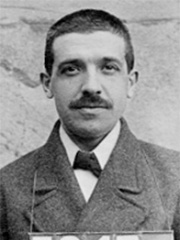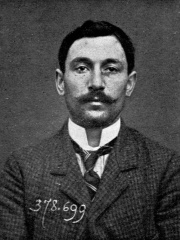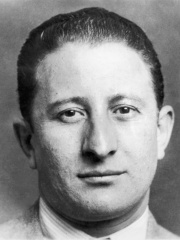







The Most Famous
EXTREMISTS from Italy
This page contains a list of the greatest Italian Extremists. The pantheon dataset contains 283 Extremists, 16 of which were born in Italy. This makes Italy the birth place of the 5th most number of Extremists behind Germany, and Saudi Arabia.
Top 10
The following people are considered by Pantheon to be the top 10 most legendary Italian Extremists of all time. This list of famous Italian Extremists is sorted by HPI (Historical Popularity Index), a metric that aggregates information on a biography's online popularity. Visit the rankings page to view the entire list of Italian Extremists.

1. Man in the Iron Mask (1640 - 1703)
With an HPI of 76.42, Man in the Iron Mask is the most famous Italian Extremist. His biography has been translated into 37 different languages on wikipedia.
The Man in the Iron Mask (French: L'Homme au Masque de Fer; died 19 November 1703) was an unidentified prisoner of state during the reign of Louis XIV of France (1643–1715). The strict measures taken to keep his imprisonment secret resulted in a long-lasting legend about his identity. Warranted for arrest on 19 July 1669 under the name of "Eustache Dauger", he was apprehended near Calais on 28 July, incarcerated on 24 August, and held for 34 years in the custody of Bénigne Dauvergne de Saint-Mars in four successive French prisons, including the Bastille. He died there on 19 November 1703, and his burial certificate bore the name of "Marchioly", leading several historians to conclude that the prisoner was Italian diplomat Ercole Antonio Mattioli. His true identity remains a mystery, even though it has been extensively debated by historians, and various theories have been expounded in numerous books, articles, poems, plays, and films. During his lifetime, it was rumoured that he was a Marshal of France or a President of Parlement, the Duke of Beaufort, or a son of Oliver Cromwell, and some of these rumours were initiated by Saint-Mars himself. Among the oldest theories is one proposed by French philosopher and writer Voltaire, who claimed in his Questions sur l'Encyclopédie (1771) that the prisoner was an older, illegitimate brother of Louis XIV. Other writers believed that he was the King's twin or younger brother. In all, more than 50 candidates, real and hypothetical, have been proposed by historians and other authors aiming to solve the mystery. What little is known about the prisoner is based on contemporaneous documents uncovered during the 19th century, mainly some of the correspondence between Saint-Mars and his superiors in Paris, initially Louvois, Louis XIV's secretary of state for war. These documents show that the prisoner was labelled "only a valet" and that he was jailed for "what he was employed to do" before his arrest, and for "what he knew". Legend has it that no one ever saw his face, as it was hidden by a mask of black velvet cloth, later misreported by Voltaire as an iron mask. Official documents reveal, however, that the prisoner was made to cover his face only when travelling between prisons after 1687, or when going to prayers within the Bastille in the final years of his incarceration; modern historians believe that the measure was imposed by Saint-Mars solely to increase his own prestige, thus causing persistent rumours to circulate about this seemingly important prisoner. In 1932, French historian Maurice Duvivier proposed that the prisoner was Eustache Dauger de Cavoye, a nobleman associated with several political scandals of the late 17th century. This solution, however, was disproved in 1953 when previously unpublished family letters were discovered by French historian Georges Mongrédien, who concluded that the enigma remained unsolved owing to the lack of reliable historical documents about the prisoner's identity and the cause of his long incarceration. He has been the subject of many works of fiction, most prominently in 1850 by Alexandre Dumas. A section of his novel The Vicomte of Bragelonne: Ten Years Later—the final installment of his D'Artagnan saga—features this prisoner portrayed as Louis XIV's identical twin and forced to wear an iron mask. In 1840, Dumas had first presented a review of the popular theories about the prisoner extant in his time in the chapter "L'homme au masque de fer", published in the eighth volume of his non-fiction Crimes Célèbres. This approach was adopted by many subsequent authors, and speculative works have continued to appear on the subject.

2. Patrizia Reggiani (b. 1948)
With an HPI of 73.77, Patrizia Reggiani is the 2nd most famous Italian Extremist. Her biography has been translated into 27 different languages.
Patrizia Reggiani (Italian: [paˈtrittsja redˈdʒaːni]; née Martinelli; born 2 December 1948) is an Italian convicted criminal and former socialite. She was convicted in a highly publicized trial of hiring a hitman to kill her ex-husband, Maurizio Gucci.

3. Charles Ponzi (1882 - 1949)
With an HPI of 71.32, Charles Ponzi is the 3rd most famous Italian Extremist. His biography has been translated into 35 different languages.
Charles Ponzi (; Italian: [ˈpontsi]; born Carlo Pietro Giovanni Guglielmo Tebaldo Ponzi; March 3, 1882 – January 18, 1949) was an Italian charlatan and con artist who operated in the United States and Canada. His aliases included Charles Ponci, Carlo, Benny Broncko and Charles P. Bianchi. Born in Lugo, Italy, he became known in the early 1920s as a swindler in North America for his money-making scheme. He promised clients a 50% profit within 45 days or 100% profit within 90 days, by buying discounted postal reply coupons in other countries and redeeming them at face value in the U.S. as a form of arbitrage. In reality, Ponzi was paying earlier investors using the investments of later investors. While this type of fraudulent investment scheme was not invented by Ponzi, it became so identified with him that it now is referred to as a "Ponzi scheme". His scheme ran for over a year before it collapsed, costing his "investors" $20 million (equivalent to $237 million in 2024). Ponzi may have been inspired by the scheme of William W. Miller (also known as "520% Miller"), a Brooklyn bookkeeper who in 1899 used a similar deception to take in $1 million (approximately $31.8 million in 2024).

4. Tommaso Buscetta (1928 - 2000)
With an HPI of 67.29, Tommaso Buscetta is the 4th most famous Italian Extremist. His biography has been translated into 26 different languages.
Tommaso Buscetta (Italian pronunciation: [tomˈmaːzo buʃˈʃetta]; 13 July 1928 – 2 April 2000) was a high-ranking Italian mobster and a member of the Sicilian Mafia. He became one of the first of its members to turn informant and explain the inner workings of the organization. Buscetta participated in criminal activity in Italy, the United States and Brazil before being arrested and extradited from Brazil to Italy. He became disillusioned with the Mafia after the murders of several of his family members, and in 1984, decided to cooperate with the authorities. He provided important testimony at the 1986/87 Maxi Trial, the largest anti-Mafia trial in history. After the murder of the judges Giovanni Falcone and Paolo Borsellino, Buscetta gave further testimony to the Antimafia Commission linking Italian politicians to the Mafia. Buscetta entered the Witness Protection Program in the United States, where he remained until his death in 2000.

5. Carlo Gambino (1902 - 1976)
With an HPI of 66.80, Carlo Gambino is the 5th most famous Italian Extremist. His biography has been translated into 27 different languages.
Carlo Gambino (Italian: [ˈkarlo ɡamˈbiːno]; August 24, 1902 – October 15, 1976) was a Sicilian crime boss who was the leader and namesake of the Gambino crime family of New York City. Following the Apalachin Meeting in 1957, and the imprisonment of Vito Genovese in 1959, Gambino took over the Commission of the American Mafia and played a powerful role in organized crime until his death from a heart attack in 1976. During a criminal career that spanned over fifty years, Gambino served only twenty-two months in prison for a tax evasion charge in 1937.

6. Johnny Torrio (1882 - 1957)
With an HPI of 66.48, Johnny Torrio is the 6th most famous Italian Extremist. His biography has been translated into 24 different languages.
John Donato Torrio (born Donato Torrio, Italian: [doˈnaːto ˈtɔrrjo]; January 20, 1882 – April 16, 1957) was an Italian-born mobster who helped build the Chicago Outfit in the 1920s later inherited by his protégé Al Capone. Torrio proposed a National Crime Syndicate in the 1930s and later became an adviser to Lucky Luciano and his Luciano crime family. Torrio had several nicknames, primarily "The Fox" for his cunning and finesse. The US Treasury official Elmer Irey considered him "the biggest gangster in America" and wrote, "He was the smartest and, I dare say, the best of all the hoodlums. 'Best' referring to talent, not morals." Virgil W. Peterson of the Chicago Crime Commission stated that his "talents as an organizational genius were widely respected by the major gang bosses in the New York City area". Crime journalist Herbert Asbury affirmed: "As an organizer and administrator of underworld affairs, Johnny Torrio is unsurpassed in the annals of American crime; he was probably the nearest thing to a real mastermind that this country has yet produced".

7. Vincenzo Peruggia (1881 - 1925)
With an HPI of 64.78, Vincenzo Peruggia is the 7th most famous Italian Extremist. His biography has been translated into 27 different languages.
Vincenzo Peruggia (8 October 1881 – 8 October 1925) was an Italian decorator best known for stealing the Mona Lisa from the Louvre, a museum in Paris where he had briefly worked as glazier, on 21 August 1911.

8. Leonarda Cianciulli (1893 - 1970)
With an HPI of 63.93, Leonarda Cianciulli is the 8th most famous Italian Extremist. Her biography has been translated into 17 different languages.
Leonarda Cianciulli (14 April 1894 – 15 October 1970) was an Italian serial killer. Better known as the Soap-Maker of Correggio (Italian: la Saponificatrice di Correggio), she murdered three women in the town of Correggio, Reggio Emilia, in 1939 and 1940, and turned their bodies into soap (using caustic soda) and teacakes.

9. Matteo Messina Denaro (1962 - 2023)
With an HPI of 63.62, Matteo Messina Denaro is the 9th most famous Italian Extremist. His biography has been translated into 31 different languages.
Matteo Messina Denaro (Italian pronunciation: [matˈtɛːo mesˈsiːna deˈnaːro]; 26 April 1962 – 25 September 2023), also known as Diabolik (from the Italian comic book character), was an Italian mafia boss from Castelvetrano. He was considered to be one of the new leaders of the Cosa Nostra after the arrests of Bernardo Provenzano on 11 April 2006 and Salvatore Lo Piccolo in November 2007. The son of a Mafia boss, Denaro became known nationally on 12 April 2001 when the magazine L'Espresso put him on the cover with the headline: Ecco il nuovo capo della Mafia ("Here is the new Mafia boss"). Messina Denaro became a fugitive on the most wanted list of the Italian Ministry of the Interior in 1993; according to Forbes in 2010, he was one of the ten most wanted and powerful criminals in the world. With the deaths of Bernardo Provenzano in 2016 and Salvatore Riina in 2017, Messina Denaro was seen as the unchallenged boss of all bosses within the Mafia. After 30 years on the run, he was arrested on 16 January 2023 near a private clinic in Sicily's capital, Palermo, where he was reportedly undergoing chemotherapy under a false name. Messina Denaro died in a prison hospital on 25 September 2023 after falling into an irreversible coma at the age of 61, after receiving treatment for colon cancer.

10. Albert Anastasia (1902 - 1957)
With an HPI of 62.89, Albert Anastasia is the 10th most famous Italian Extremist. His biography has been translated into 22 different languages.
Umberto "Albert" Anastasia (, Italian: [umˈbɛrto anastaˈziːa]; né Anastasio [anaˈstaːzjo]; September 26, 1902 – October 25, 1957) was an Italian-American mobster, hitman and crime boss. One of the founders of the modern American Mafia, and a co-founder and later boss of the Murder, Inc. organization, Anastasia eventually rose to the position of boss in what became the modern Gambino crime family. He also controlled New York City's waterfront for most of his criminal career, mainly through dockworker unions. Anastasia was murdered on October 25, 1957, on the orders of Vito Genovese and Carlo Gambino; Gambino subsequently became the boss of the family. Anastasia was one of the most ruthless and feared organized crime figures in American history; his reputation earned him the nicknames The Earthquake, The One-Man Army, The Mad Hatter and The Lord High Executioner.
People
Pantheon has 16 people classified as Italian extremists born between 1640 and 1962. Of these 16, 1 (6.25%) of them are still alive today. The most famous living Italian extremists include Patrizia Reggiani. The most famous deceased Italian extremists include Man in the Iron Mask, Charles Ponzi, and Tommaso Buscetta.
Living Italian Extremists
Go to all RankingsDeceased Italian Extremists
Go to all RankingsMan in the Iron Mask
1640 - 1703
HPI: 76.42
Charles Ponzi
1882 - 1949
HPI: 71.32
Tommaso Buscetta
1928 - 2000
HPI: 67.29
Carlo Gambino
1902 - 1976
HPI: 66.80
Johnny Torrio
1882 - 1957
HPI: 66.48
Vincenzo Peruggia
1881 - 1925
HPI: 64.78
Leonarda Cianciulli
1893 - 1970
HPI: 63.93
Matteo Messina Denaro
1962 - 2023
HPI: 63.62
Albert Anastasia
1902 - 1957
HPI: 62.89
Luciano Leggio
1925 - 1993
HPI: 62.81
Frank Nitti
1886 - 1943
HPI: 62.32
Sante Geronimo Caserio
1873 - 1894
HPI: 62.13
Overlapping Lives
Which Extremists were alive at the same time? This visualization shows the lifespans of the 14 most globally memorable Extremists since 1700.




